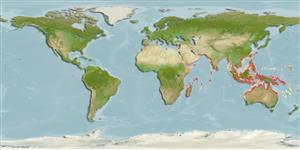Teleostei >
Clupeiformes (Herrings)
鯡形目 (Herrings) >
Engraulidae (Anchovies)
鯷科 (Anchovies) > Coiliinae
Etymology: Thryssa: Greek, thrissa, -es = shad (Ref. 45335).
Environment: milieu / climate zone / depth range / distribution range
生態學
海洋; 半鹹淡水; 深度上下限 1 - 20 m (Ref. 6898). 熱帶; 28°N - 40°S, 21°E - 170°E (Ref. 189)
Indo-Pacific: India Ocean from Gulf of Oman south to Port Alfred, but no records from the Red Sea and Madagascar; coasts of Pakistan, India and probably Burma; Thailand, Indonesia, Philippines to Taiwan (Ref. 189), including Arafura Sea (Ref. 9819); also northern Australia, Papua New Guinea, Solomon Islands and New Hebrides (Ref. 189).
印度-太平洋: 阿曼灣南至艾佛烈港, 沒有來自紅海與馬達加斯加的紀錄; 巴基斯坦,印度的海岸, 可能緬甸; 泰國,印尼, 菲律賓到台灣; 也阿拉弗拉海 (參考文獻 9819) ,澳洲北部,巴布亞新幾內亞,索羅門群島與新海布里群島。
Length at first maturity / 大小 / 重量 / 年齡
Maturity: Lm 16.0 range ? - ? cm
Max length : 18.0 cm SL 雄魚/尚未辨別雌雄; (Ref. 9822); common length : 15.0 cm SL 雄魚/尚未辨別雌雄; (Ref. 9822)
背棘 (總數) : 0; 背的軟條 (總數) : 14 - 16; 臀棘: 0; 臀鰭軟條: 32 - 39. Diagnosis: Body fairly compressed, belly with 16-18 plus 9-10, with a total of 25-28 keeled scutes; lower gill rakers 10-12; head with gold tints; anal and caudal fins deep yellow; a black area behind upper part of gill opening (Ref. 189). It is distinguished from all other Thryssa species and in fact all other anchovies by the very long maxilla, reaching at least to tip of pectoral fin, usually to pelvic fin base or even to anal fin origin; also unique is the high coronoid process of the lower jaw, the jaw rising steeply in the mouth (Ref. 189).
腹面有 25 到 28個有龍骨的鱗甲。 與所有的其他 Thryssa 種與鯷魚區分了藉由非常長的顎骨, 至少到胸鰭頂端, 通常到腹鰭基底或甚至到臀鰭起源; 也獨特的是下面頜的高下顎齒骨冠突,頜陡升在嘴巴中。 頭部有金色的色彩; 臀鰭與尾鰭深黃色; 在鰓後面的深色斑點。
Marine, pelagic, presumably schooling, occurring mostly close inshore, entering bays and estuaries (Ref. 189, 30573). Recorded at a temperature range of 26.0-29.0 °C in the Trinity Inlet system, Australia (Ref. 4959). It feeds mainly on crustaceans, like amphipods, zoea larvae, Acetes (Ref. 189, 30573). May be caught using ringnets (Ref. 5213). Used as bait in the tuna fishery in the South Pacific.
推測為群游大部份出現 (或總是 ?) 近岸與灣內與河口。 在澳洲的三合水灣系統中的一個 26.0-29.0 °C 的溫差記錄。 (參考文獻 4959) 主要吃甲殼動物。 (海蟹幼蟲,片腳類動物, Acetes) 需要更多的資料, 包括一些功能的解釋為特別長的小顎。 可能是使用環狀網捕捉。 (參考文獻 5213) 在南太平洋的鮪魚業當作魚餌了。
印度-太平洋: 阿曼灣南至艾佛烈港, 沒有來自紅海與馬達加斯加的紀錄; 巴基斯坦,印度的海岸, 可能緬甸; 泰國,印尼, 菲律賓到台灣; 也阿拉弗拉海 (參考文獻 9819) ,澳洲北部,巴布亞新幾內亞,索羅門群島與新海布里群島。
Wongratana, T., T.A. Munroe and M. Nizinski, 1999. Order Clupeiformes. Engraulidae. Anchovies. p. 1698-1753. In K.E. Carpenter and V.H. Niem (eds.) FAO species identification guide for fishery purposes. The living marine resources of the WCP. Vol. 3. Batoid fishes, chimaeras and bony fishes part 1 (Elopidae to Linophrynidae). FAO, Rome. (Ref. 9822)
人類使用
漁業: 低經濟; 誘餌: usually
工具
特別的報告
下載 XML
網路資源
Estimates based on models
Preferred temperature (Ref.
123201): 24.9 - 29.3, mean 28.5 °C (based on 3124 cells).
Phylogenetic diversity index (Ref.
82804): PD
50 = 0.5000 [Uniqueness, from 0.5 = low to 2.0 = high].
Bayesian length-weight: a=0.00776 (0.00483 - 0.01247), b=3.09 (2.96 - 3.22), in cm total length, based on LWR estimates for this species & (Sub)family-body (Ref.
93245).
營養階層 (Ref.
69278): 3.3 ±0.48 se; based on food items.
Generation time: 2.7 ( na - na) years. Estimated as median ln(3)/K based on 2
growth studies.
回復力 (Ref.
120179): 高度, 族群倍增時間少於 15個月 (Preliminary K or Fecundity.).
Fishing Vulnerability (Ref.
59153): Low vulnerability (11 of 100).
Nutrients (Ref.
124155): Calcium = 204 [124, 477] mg/100g; Iron = 1.55 [0.84, 2.70] mg/100g; Protein = 19 [18, 20] %; Omega3 = 0.449 [0.226, 0.957] g/100g; Selenium = 27.8 [13.5, 59.9] μg/100g; VitaminA = 24.7 [6.9, 69.6] μg/100g; Zinc = 1.99 [1.37, 2.86] mg/100g (wet weight);
